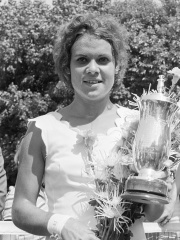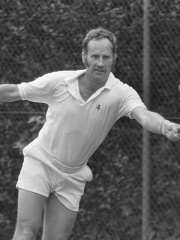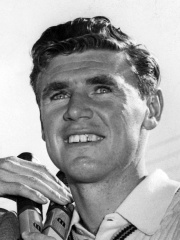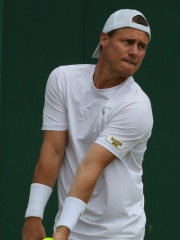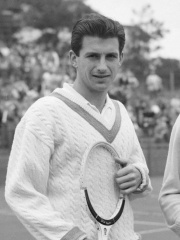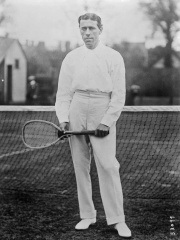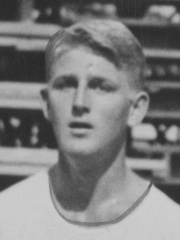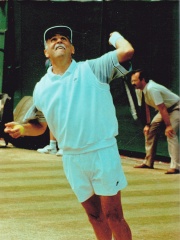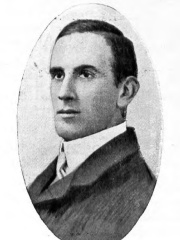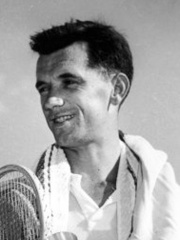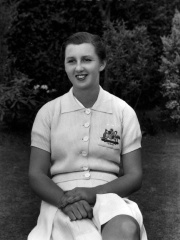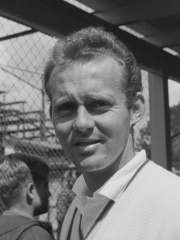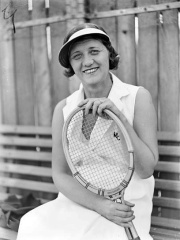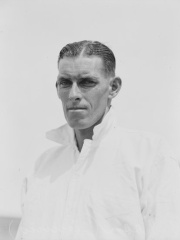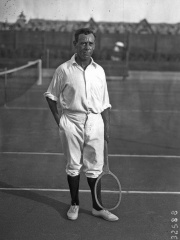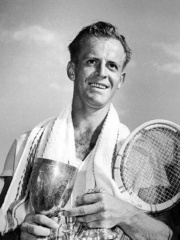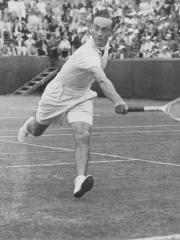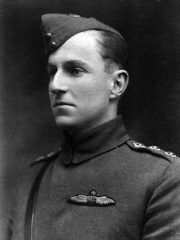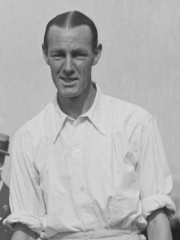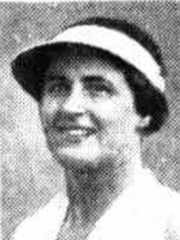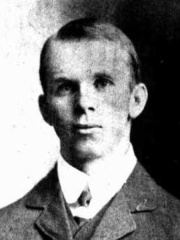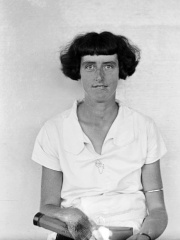
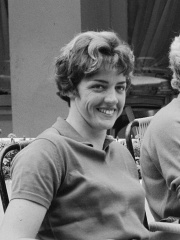
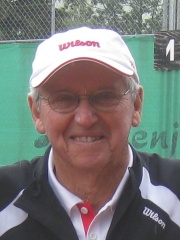
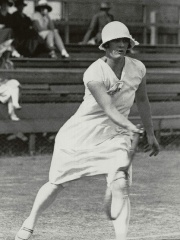
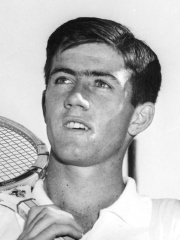
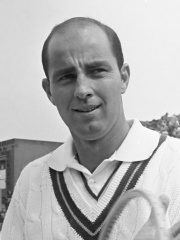
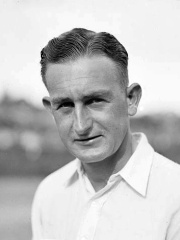
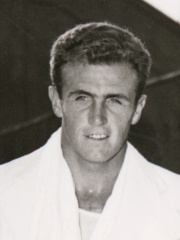
The Most Famous
TENNIS PLAYERS from Australia
This page contains a list of the greatest Australian Tennis Players. The pantheon dataset contains 1,569 Tennis Players, 74 of which were born in Australia. This makes Australia the birth place of the 2nd most number of Tennis Players.
Top 10
The following people are considered by Pantheon to be the top 10 most legendary Australian Tennis Players of all time. This list of famous Australian Tennis Players is sorted by HPI (Historical Popularity Index), a metric that aggregates information on a biography’s online popularity. Visit the rankings page to view the entire list of Australian Tennis Players.

1. Rod Laver (b. 1938)
With an HPI of 67.28, Rod Laver is the most famous Australian Tennis Player. His biography has been translated into 55 different languages on wikipedia.
Rodney George Laver (born 9 August 1938) is an Australian former tennis player. Laver was ranked the world number 1 professional player indisputably for five years from 1965 to 1969 and by some sources also in 1964 and 1970. He was also ranked as the number 1 amateur in 1961 and 1962. Laver won 198 singles titles which is the most won by a player in history.Laver won 11 Grand Slam singles titles and 8 Pro Majors titles. He completed the Grand Slam (winning all four slams in a calendar year) in singles twice in 1962 and 1969; the latter remains the only time a man has done so in the Open Era. He also completed the Pro Slam (winning all three pro majors in one year) in 1967. Laver won titles on all court surfaces of his time: grass, clay, hard, carpet, wood and he contributed to five Davis Cup titles for Australia during an age when the Davis Cup was deemed as significant as the four majors. The Rod Laver Arena and the Laver Cup tournament are named after him.

2. Margaret Court (b. 1942)
With an HPI of 65.02, Margaret Court is the 2nd most famous Australian Tennis Player. Her biography has been translated into 55 different languages.
Margaret Court (née Smith; born 16 July 1942), also known as Margaret Smith Court, is an Australian former world No. 1 tennis player and a Christian minister. Considered one of the greatest tennis players of all time, her 24 women's singles major titles and total of 64 major titles (including 19 major women's doubles and 21 major mixed doubles titles) are the most in tennis history. Court was born in Albury, New South Wales. In 1960, aged 17, she won the first of seven consecutive Australian Open singles titles. She completed the career Grand Slam in singles aged 21 with her victory at Wimbledon in 1963. Taking a brief hiatus in 1966 and 1967, Court played as an amateur until the advent of the Open Era in 1968. She completed the Grand Slam by winning all four major singles titles in 1970, part of a record six consecutive major singles victories. Court gave birth to her first child in 1972, but returned to tennis later in the year and won three major singles titles in 1973. She took similar breaks after her second and third children were born, retiring from the game in 1977. Court's all-surface (hard, clay, grass and carpet) singles career-winning percentage of 91.69 is the fourth best of all time. Her Open-Era singles career winning percentage of 91.02% (608–60) is unequalled, as is her Open-Era winning percentage of 91.67% (11–1) in major singles finals. Her win–loss performance in all major singles tournaments was 90.00% (207–23). She was 95.24% (60–3) at the Australian Open, 89.80% (44–5) at the French Open, 85.00% (51–9) at Wimbledon, and 89.66% (52–6) at the US Open. She also shares the Open-Era record for most major singles titles won as a mother with Kim Clijsters, at three. In 1973, Court set the record for the most singles titles won at a single major (for either women's or men's), with 11 Australian Open titles. This record was surpassed by Rafael Nadal in 2019 when he won his 12th French Open title, but it remains a women's record. Court is one of only three players in history (all women) to have won the "Boxed Set", consisting of every major title (the singles, doubles and mixed doubles). She is the only player in tennis history to complete a double Boxed Set. Uniquely, she won all twelve events as an amateur and then, after a hiatus from the sport, returned as a professional to win all twelve again (including a shared title in the 1969 Australian Open mixed doubles, after the final was abandoned and not contested). Court is also one of only six tennis players to win a double career Grand Slam in two disciplines, matching Roy Emerson, Martina Navratilova, Frank Sedgman, Doris Hart, and Serena Williams. She also won the Fed Cup with Australia on four occasions. The International Tennis Hall of Fame states "For sheer strength of performance and accomplishment there has never been a tennis player to match (her)." In 2010, the Herald Sun called her the greatest female tennis player of all time, a view supported by Evonne Goolagong Cawley.Having grown up as a Roman Catholic, Court became associated with Pentecostalism in the 1970s and became a Christian minister in that tradition in 1991. She later founded Margaret Court Ministries.

3. Roy Emerson (b. 1936)
With an HPI of 58.74, Roy Emerson is the 3rd most famous Australian Tennis Player. His biography has been translated into 39 different languages.
Roy Stanley Emerson (born 3 November 1936) is an Australian former tennis player who won 12 Grand Slam singles titles and 16 Grand Slam doubles titles, for a total of 28 Grand Slam titles. All of his singles Grand Slam victories and 14 of his Grand Slam doubles victories were achieved before the open era began in 1968. He is the only male player to have completed a career Grand Slam (winning titles at all four Grand Slam events) in both singles and doubles, and the first of four male players to complete a double career Grand Slam in singles (later followed by Rod Laver, Novak Djokovic, and Rafael Nadal). His 28 major titles are the all-time record for a male player. He was ranked world No. 1 amateur in 1961 by Ned Potter, 1964 by Potter, Lance Tingay and an Ulrich Kaiser panel of 14 experts and 1965 by Tingay, Joseph McCauley, Sport za Rubezhom and an Ulrich Kaiser panel of 16 experts.Emerson was the first male player to win 12 singles majors. He held that record for 30 years until it was passed by Pete Sampras in 2000. He also held the record of six Australian Open men's singles titles until 2019 when Novak Djokovic won his seventh title. Emerson won five of those titles consecutively (1963–67), a still-standing record. Emerson is one of only five tennis players ever to win multiple slam sets in two disciplines. Emerson was a member of a record eight Davis Cup–winning teams between 1959 and 1967. Unlike several of his contemporaries, he chose to remain an amateur player and did not turn pro during the pre-Open Era.

4. Coral Buttsworth (1900 - 1985)
With an HPI of 56.79, Coral Buttsworth is the 4th most famous Australian Tennis Player. Her biography has been translated into 17 different languages.
Coral Annabell Buttsworth (née McInnes; 7 June 1900 – 20 December 1985) was a female tennis player from Australia who won the singles title at the Australian Championships in 1931 and 1932 and the women's doubles title there in 1932. In 1933 she again made the final of the Australian Championships but was defeated in straight sets by first-seeded Joan Hartigan.Buttsworth was the only multiple winner of the singles title at the Australian Championships who never won a state singles title. A strong, thick-set woman from Sydney, she was addicted to chopping the ball, with an excellent drop shot, and was quick around the court. She was a player who preferred to maneuver opponents out of position by running them up and back on the court rather than from side to side.
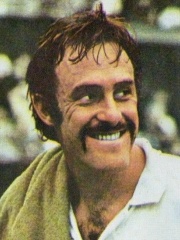
5. John Newcombe (b. 1944)
With an HPI of 56.74, John Newcombe is the 5th most famous Australian Tennis Player. His biography has been translated into 42 different languages.
John David Newcombe AO OBE (born 23 May 1944) is an Australian former professional tennis player. He is one of the few men to have attained a world No. 1 ranking in both singles and doubles. At the majors, he won seven singles titles, a former record 17 men's doubles titles, and two mixed doubles titles. He also contributed to five Davis Cup titles for Australia during an age when the Davis Cup was deemed as significant as the majors. Tennis magazine rated him the 10th best male player of the period 1965–2005.

6. Ken Rosewall (b. 1934)
With an HPI of 56.15, Ken Rosewall is the 6th most famous Australian Tennis Player. His biography has been translated into 38 different languages.
Kenneth Robert Rosewall (born 2 November 1934) is an Australian former world top-ranking professional tennis player. Rosewall won 147 singles titles, including a record 15 Pro Majors and 8 Grand Slam titles for a total 23 titles at pro and amateur majors. He also won 15 Pro Majors in doubles and 9 Grand Slam doubles titles. Rosewall achieved a Pro Slam in singles in 1963 by winning the three Pro Majors in one year and he completed the Career Grand Slam in doubles. Rosewall had a renowned backhand and enjoyed a long career at the highest levels from the early 1950s to the early 1970s. Rosewall was ranked as the world No. 1 tennis player by multiple sources from 1961 to 1964, multiple sources in 1970 and Rino Tommasi in 1971 and 1972. Rosewall was first ranked in the top 20 in 1952 and last ranked in the top 20 in 1977. Rosewall is the only player to have simultaneously held Pro Grand Slam titles on three different surfaces (1962–63). At the 1971 Australian Open, he became the first man during the Open Era to win a Grand Slam tournament without dropping a set. Rosewall won world professional championship tours in 1963, 1964, and the WCT titles in 1971 and 1972. A natural left-hander, Rosewall was taught by his father to play right-handed. He developed a powerful, effective backhand but never had anything more than an accurate but relatively soft serve. He was 1.70 m (5 ft 7 in) tall, weighed 67 kg (148 lb) and sarcastically was nicknamed "Muscles" by his fellow-players because of his lack of them. He was, however, fast, agile, and tireless, with a deadly volley. A father of two and grandfather of five, Rosewall lives in northern Sydney.

7. Bob Hewitt (b. 1940)
With an HPI of 52.37, Bob Hewitt is the 7th most famous Australian Tennis Player. His biography has been translated into 24 different languages.
Robert Anthony John Hewitt (born 12 January 1940) is a former professional tennis player from Australia. In 1967, after marrying a South African, he became a South African citizen. He has won 15 major titles and a career Grand Slam in both men's and mixed doubles. In 2015, he was convicted of rape and sexual assault of girls he was coaching in the 1980s and 1990s; Hewitt was sentenced to six years in jail, and was subsequently expelled from the International Tennis Hall of Fame.

8. Jack Crawford (1908 - 1991)
With an HPI of 52.34, Jack Crawford is the 8th most famous Australian Tennis Player. His biography has been translated into 21 different languages.
John Herbert Crawford, (22 March 1908 – 10 September 1991) was an Australian tennis player during the 1930s. He was the World No. 1 amateur for 1933, during which year he won the Australian Open, the French Open, and Wimbledon, and was runner-up at the U.S. Open in five sets, thus missing the Grand Slam by one set that year. He also won the Australian Open in 1931, 1932, and 1935. He was inducted into the International Tennis Hall of Fame in 1979.

9. Ken McGregor (1929 - 2007)
With an HPI of 51.44, Ken McGregor is the 9th most famous Australian Tennis Player. His biography has been translated into 20 different languages.
Kenneth Bruce McGregor (2 June 1929 – 1 December 2007) was an Australian tennis player from Adelaide who won the Men's Singles title at the Australian Championships in 1952. He and his longtime doubles partner, Frank Sedgman, are generally considered one of the greatest men's doubles teams of all time and won the doubles Grand Slam in 1951. McGregor was also a member of three Australian Davis Cup winning teams in 1950–1952. In 1953, Jack Kramer induced both Sedgman and McGregor to turn professional. He was ranked as high as World No. 3 in 1952.
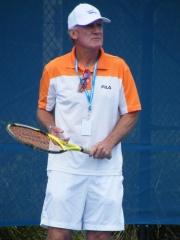
10. Tony Roche (b. 1945)
With an HPI of 51.43, Tony Roche is the 10th most famous Australian Tennis Player. His biography has been translated into 23 different languages.
Anthony Dalton Roche AO MBE (born 17 May 1945) is an Australian former professional tennis player. A native of Tarcutta, Roche played junior tennis in the New South Wales regional city of Wagga Wagga. He won one Grand Slam singles title, the 1966 French Open at Roland Garros, and 15 Grand Slam doubles titles. In 1968, Roche won the WCT/NTL combined professional championship in men's singles in the final event of the season at Madison Square Garden. He was ranked World No. 2 by Lance Tingay of The Daily Telegraph in 1969.He won the U.S. Pro Championships in 1970 at Longwood in Boston. Roche won the New South Wales Open twice, in 1969 and 1976. He won a key Davis Cup singles match in 1977. He also coached multi-Grand Slam winning world No. 1s Ivan Lendl, Patrick Rafter, Roger Federer and Lleyton Hewitt as well as former World No. 4 Jelena Dokic.
People
Pantheon has 110 people classified as Australian tennis players born between 1867 and 1999. Of these 110, 78 (70.91%) of them are still alive today. The most famous living Australian tennis players include Rod Laver, Margaret Court, and Roy Emerson. The most famous deceased Australian tennis players include Coral Buttsworth, Jack Crawford, and Ken McGregor. As of April 2024, 36 new Australian tennis players have been added to Pantheon including Owen Davidson, Rodney Heath, and Marjorie Cox Crawford.
Living Australian Tennis Players
Go to all RankingsRod Laver
1938 - Present
HPI: 67.28
Margaret Court
1942 - Present
HPI: 65.02
Roy Emerson
1936 - Present
HPI: 58.74
John Newcombe
1944 - Present
HPI: 56.74
Ken Rosewall
1934 - Present
HPI: 56.15
Bob Hewitt
1940 - Present
HPI: 52.37
Tony Roche
1945 - Present
HPI: 51.43
Evonne Goolagong Cawley
1951 - Present
HPI: 50.89
Neale Fraser
1933 - Present
HPI: 49.58
Fred Stolle
1938 - Present
HPI: 49.47
Frank Sedgman
1927 - Present
HPI: 48.66
Lleyton Hewitt
1981 - Present
HPI: 47.69
Deceased Australian Tennis Players
Go to all RankingsCoral Buttsworth
1900 - 1985
HPI: 56.79
Jack Crawford
1908 - 1991
HPI: 52.34
Ken McGregor
1929 - 2007
HPI: 51.44
Ashley Cooper
1936 - 2020
HPI: 49.36
Norman Brookes
1877 - 1968
HPI: 49.14
John Bromwich
1918 - 1999
HPI: 49.14
Lew Hoad
1934 - 1994
HPI: 49.06
Owen Davidson
1943 - 2023
HPI: 48.92
Rodney Heath
1884 - 1936
HPI: 48.43
Mervyn Rose
1930 - 2017
HPI: 48.28
Nancye Wynne Bolton
1916 - 2001
HPI: 47.97
Ken Fletcher
1940 - 2006
HPI: 47.27
Newly Added Australian Tennis Players (2024)
Go to all RankingsOwen Davidson
1943 - 2023
HPI: 48.92
Rodney Heath
1884 - 1936
HPI: 48.43
Marjorie Cox Crawford
1903 - 1983
HPI: 47.10
Edgar Moon
1904 - 1976
HPI: 44.56
Horace Rice
1872 - 1950
HPI: 44.20
Rex Hartwig
1929 - 2022
HPI: 43.25
Vivian McGrath
1916 - 1978
HPI: 43.24
Arthur O'Hara Wood
1890 - 1918
HPI: 43.06
James Anderson
1894 - 1973
HPI: 42.87
Margaret Molesworth
1894 - 1985
HPI: 42.86
Ernie Parker
1883 - 1918
HPI: 41.97
Emily Hood Westacott
1910 - 1980
HPI: 41.56
Overlapping Lives
Which Tennis Players were alive at the same time? This visualization shows the lifespans of the 25 most globally memorable Tennis Players since 1700.

